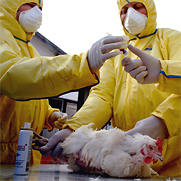Michael Tu
May 3, 2012
View the full Nuclear Threat Initiative Article:
Between Publishing and Perishing
Between Publishing and Perishing?

Scientists continue studying the H5N1 virus, US Department of State
In June 2012, teams of virologists in the Netherlands and the United States published two research articles, “Airborne Transmission of Influenza A/H5N1 Virus Between Ferrets and “The Potential for Respiratory Droplet–Transmissible A/H5N1 Influenza Virus to Evolve in a Mammalian Host,” in the highly respected journal Science. The articles describe how a few deliberately engineered mutations might enable the H5N1 avian influenza virus, which typically infects birds, to become transmissible between ferrets. As ferrets possess certain genetic characteristics that resemble those of humans, concern immediately arose among both scientists and the general public that if the newly created strain of H5N1 influenza virus was somehow to escape the laboratory, or be deliberately released, it might prove to be easily transmissible from one human to another and thus cause a pandemic. Even before the articles were published, scientists, policy-makers, and editors of scientific journals debated whether some or all of the data generated by the research should be withheld or that it could be published in its entirety and be freely accessible.
Those who did not want the research findings to be published argued that it had resulted in so-called “gain of function” by a pathogen, which violated the 1975 NIH guidelines on recombinant DNA research prohibiting research that endows a pathogen with new or enhanced pathogenic capabilities. Further, if the data was published, in the future bioterrorists could use it to develop a unique strain of influenza virus and release it for the purpose of causing a world-wide pandemic.
Those who were for free accessibility argued that given the challenges posed annually to public health by seasonal influenza, as well as the episodic appearances of pandemic influenza, there is a continuous need for basic research that generates findings that can be used to improve society’s ability to prevent and treat influenza. In particular, science still lacks information on the complex factors that bear on animal-animal transmissibility of influenza viruses, as well as between animals and humans. Therefore the data generated by the research would be useful to scientists who sought to conduct further research that aim to protect the world’s population from new strains of influenza that undoubtedly will appear in the future.
The Final Decision: H5N1 Research Controversy
After the issues were considered for 8 months, the decision was made to allow the articles to be published in their entirety and be freely available to everyone. Depending on one’s viewpoint, the publication of the two articles benefited public health experts trying to protect a vulnerable world from a new influenza pandemic, or future bioterrorists aiming to cause unleashed mayhem on the world’s population.
